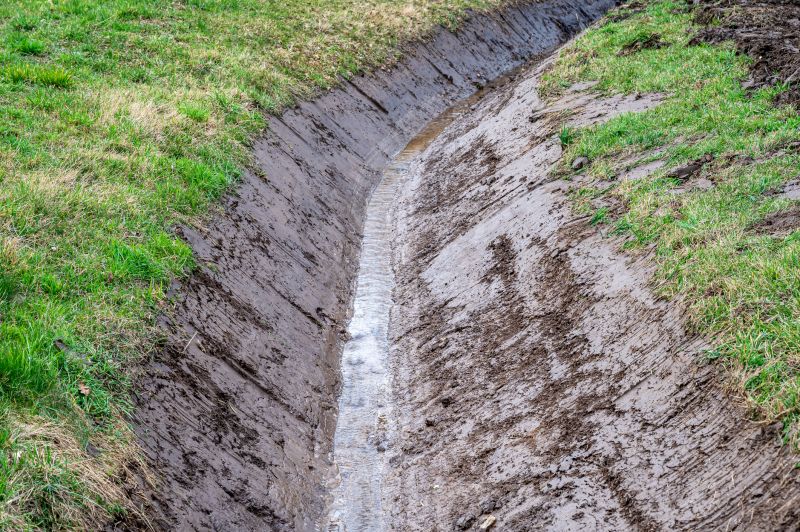Ultimate Ditch Drainage Equipment For Reliable Water Flow
Find high-performance ditch drainage tools and systems crafted to ensure consistent water removal and soil protection.
 Proper drainage in ditches is essential for managing water flow and preventing erosion or flooding in various landscapes. Selecting the right products for ditch drainage can improve water management efficiency, reduce maintenance efforts, and enhance the longevity of the infrastructure. Ditch drainage solutions come in many forms, including flexible piping, perforated pipes, drainage mats, and specialized fittings designed to adapt to different terrain types. When choosing drainage products, it is important to consider factors such as soil type, water volume, and the specific function of the drainage system.
Proper drainage in ditches is essential for managing water flow and preventing erosion or flooding in various landscapes. Selecting the right products for ditch drainage can improve water management efficiency, reduce maintenance efforts, and enhance the longevity of the infrastructure. Ditch drainage solutions come in many forms, including flexible piping, perforated pipes, drainage mats, and specialized fittings designed to adapt to different terrain types. When choosing drainage products, it is important to consider factors such as soil type, water volume, and the specific function of the drainage system.
Top Overall Option
Flexible Perforated Drain Pipe
A versatile and widely used drainage component, flexible perforated drain pipes are designed to adapt to various landscape contours while allowing water to flow through their perforations. Made from durable, weather-resistant materials, they facilitate effective drainage in different soil conditions and are suitable for both residential and agricultural applications. Easy to install and maintain, these pipes help manage excess water and reduce the risk of erosion or flooding.
Types of Products For Ditich Drainages
Perforated Drain Pipes
Designed to allow water to seep into the pipe while filtering out debris, perforated drain pipes are common in many drainage systems.
Drainage Mats and Panels
These products reinforce ditch walls and prevent collapse, especially in unstable soils or steep slopes.
Geotextile Fabrics
Used to filter soil particles and debris, geotextiles help keep drainage systems clear and functioning efficiently.
Corrugated Drain Pipes
Flexible and durable, corrugated pipes are suitable for irregular terrain and heavy water flow.
Drainage Fittings and Connectors
Essential for joining pipes and customizing drainage layouts to fit specific site conditions.
Drainage Gravel and Aggregate
Used as a bedding material to improve water flow and stabilize pipe installations.
Outlet Catch Basins
Capture surface runoff and direct it into the drainage system, preventing surface water pooling.
Erosion Control Blankets
Help stabilize ditch banks and prevent soil erosion during and after installation.
Drainage Socks
Flexible sleeves filled with gravel or filter material, used to protect pipes and improve water flow.
Waterproof Sealants and Gaskets
Ensure leak-proof connections between drainage components and prevent water ingress.
Popular Choices
Widely used in various drainage setups, these pipes facilitate water movement while filtering out debris.
Commonly used as a bedding or backfill material, helping to improve water flow and pipe stability.
Applied to filter soil and debris, keeping drainage systems clear.
Capture surface runoff and direct water into underground systems.
Flexible and durable, suitable for challenging terrain or high water volumes.
Help prevent soil erosion on ditch banks and slopes.
Facilitate seamless joining of multiple drainage components.
Ensure tight seals at pipe joints and fittings.
Help direct water flow from the system to designated areas.
Protect pipes and enhance water flow efficiency.
Allow for easy system inspection and maintenance.
Ideal for adapting to complex landscapes and tight spaces.
Stabilizes soil and prevents erosion around drainage systems.
Connect multiple pipes and components for customized layouts.
Provides support and enhances water movement around pipes.
Cover surface outlets and prevent debris entry.
Assist in fixing leaks or damages in existing drainage systems.
Designed to handle large volumes of surface runoff efficiently.
Effective ditch drainage often involves a combination of components tailored to the site’s needs. For example, perforated pipes facilitate water flow while preventing soil infiltration, and geotextile fabrics can help filter debris to keep the system clear. Drainage mats and panels may be used to reinforce the ditch walls and prevent collapse, especially in areas prone to erosion. Proper installation and selection of appropriate accessories can significantly impact the performance and durability of a drainage system.
Maintenance is another key aspect to consider when planning ditch drainage solutions. Products that allow for easy inspection, cleaning, and repair can save time and effort over the lifespan of the system. Additionally, choosing corrosion-resistant and weatherproof materials ensures longevity in outdoor environments. Whether for agricultural fields, residential landscaping, or roadside infrastructure, the right ditch drainage products can contribute to effective water management and help mitigate potential water-related issues.
Key Buying Considerations
- Assess the water volume and flow rate to select appropriately rated products.
- Consider soil type and stability to determine suitable drainage materials and reinforcement options.
- Evaluate the terrain's slope and layout to optimize pipe placement and drainage efficiency.
- Choose corrosion-resistant and weatherproof materials for durability in outdoor environments.
- Determine the size and diameter of pipes based on the expected water load and space constraints.
- Think about ease of installation and maintenance requirements for long-term system management.
- Select compatible fittings and connectors to ensure seamless assembly of drainage components.
- Incorporate filtration elements like geotextiles or drainage fabrics to prevent clogging.
- Plan for future expansion or modifications by selecting modular and adaptable products.
- Prioritize products with clear installation instructions and support resources.
- Consider the environmental conditions, such as freeze-thaw cycles, that may impact material performance.
- Review local building codes or regulations related to drainage system installation.
- Estimate the overall system cost, including materials, labor, and ongoing maintenance.
- Evaluate the availability of replacement parts and accessories for long-term upkeep.
- Determine the aesthetic impact, especially in residential or landscaped areas, to ensure visual harmony.
